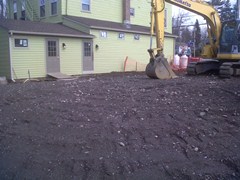Installing a Septic System
At Onsite Engineering, we seek the simplest, most effective means of installing, replacing, or expanding septic systems to meet the needs of your property. After years in the industry, we are yet to find a challenge that we haven't been able to overcome, including sensitive lakefront properties that flow into drinking water sources. This is a breakdown of the steps we take for each project:
1. Site investigation
Land and soil characteristics present unique challenges on each project and ultimately dictates the complexity of the system. These are some of the factors we look for:
- Slope of Grade
- Regulatory Distance Requirements
- Individual Lot Size
The following are pictures of challenging lakefront projects that we've completed at Skaneateles Lake as part of the Skaneateles Lake Demonstration Project:
At every site, we also take a look at the structure and characteristics of the soil below grade to determine the best system for your site needs. These characteristics include:
- Soil Composition
- Proximity to Water Table
- Hydraulic Conductivity (Percolation Rate)
4-6 foot deep test holes are excavated at key points on the property to gain insight into soil composition and seasonal high water table. We typically want at least 2 feet of soil above the water table for structural purposes and to determine how the land profile will need to be manipulated. The percolation test tells us the rate of water infiltration into the natural soil, allowing us to size the drainfield and determine if new fill material will need to be imported onto the site.
2. Engineering Design
With a complete understanding of natural land features, lead engineer Eric E. Murdock, P.E. will design and develop your onsite wastewater treatment system and generate professional design drawings that will be approved by local regulatory agencies.
Some examples of our engineering work:






3. Construction
With approved drawings, a contractor is hired to ensure that the septic system is properly installed though professional experience and frequent communication with the engineer. We are happy to give referrals, but the choice of a contractor is ultimately up to you.
4. Maintenance
Proper maintenance of your septic system is necessary in order to preserve the functionality of the system and the health of the environment and the public. Damaged systems costs thousands of dollars to fix or replace, and diminishes the worth of your property if poorly maintained.
The EPA specifies the top four contributions by a homeowner to protect their septic system:
- Regularly inspect and pump the system as necessary
- Use water efficiently
- Do not dispose of hazardous wastes in sinks or toilets
- Care for your drainfield
Please review the EPA's complete guide of septic systems for more information.













